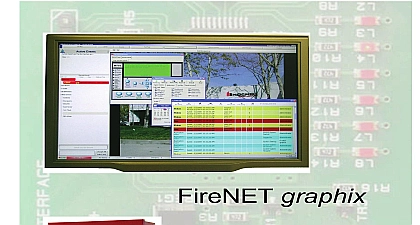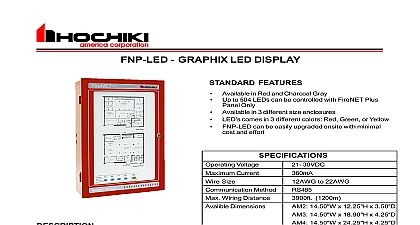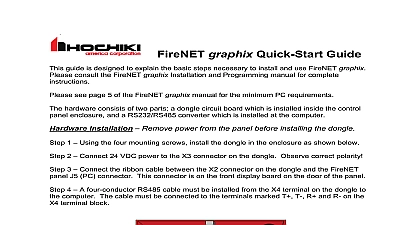Hochiki FNP-LED Graphic LED Display IO V1 0

File Preview
Click below to download for free
Click below to download for free
File Data
| Name | hochiki-fnp-led-graphic-led-display-io-v1-0-1284579306.pdf |
|---|---|
| Type | |
| Size | 1.43 MB |
| Downloads |
Text Preview
FireNET Plus Graphix LED Display and Operation Manual America Corporation Village Drive Suite 100 Park CA 90621 2268 Corporate Headquarters Technical Support 1.0 04 10 09 10 30 09 1700 11000 of Contents of Contents 2 cid 2 1 Introduction 3 cid 2 Limitations of Fire Alarm Systems 3 cid 2 2 General Wiring Specifications 6 cid 2 3 Installing the FNP LED Graphic LED Display 7 cid 2 Overview of the FNP LED 7 cid 2 Enclosure Sizes and Options 7 cid 2 Controls and Indications 8 cid 2 Specifications 9 cid 2 Mounting 9 cid 2 Connections 10 cid 2 Terminating Jumper 11 cid 2 Addressing 12 cid 2 Programming 13 cid 2 Adding or Changing LED Positions 13 cid 2 Maintenance 14 cid 2 A 15 cid 2 the FNP LED Graphic LED Display 15 cid 2 25 cid 2 FNP LED I O Manual UL 1 Introduction FireNET FNP LED Graphic LED Display provides a flexible and expandable for graphical LED display panels via a simple four wire data link connected to FireNET Plus control panel FW version must be V07.0000 or higher Limitations of Fire Alarm Systems Recommended Installation Guidelines To achieve early fire detection fire sensors should be installed in all rooms and areas of a house apartment building in accordance with the recommendations of the National Fire Protection Standard 72 NFPA 72 manufacturer recommendations state and codes and the recommendations contained in Guide for the Proper Use of Smoke Detectors which is made available at no charge to all installing Generally the standards and recommendations include the following but should refer to the specific guidelines above before installing Sleeping Rooms Smoke detectors should be installed in every sleeping more than 30 feet long Hallways More than one smoke detector should be installed in a hallway if it At least Two Smoke Detectors There should never be less than two smoke per apartment or residence Smoke Detectors in Alarm Electrical or Phone Locations Smoke detectors be located in any room where an alarm control is located or an alarm connects to an electrical source or phone line If detectors are not so a fire within the room could prevent the alarm control from reporting a Notification Systems All fire alarm systems require notification devices sirens bells horns and or strobes In residential applications each alarm initiating device when activated should cause the operation of notification device that should be clearly audible in all bedrooms over or background noise levels at least 15dB above noise with all doors closed Alarm in Every Bedroom and Level of Residence A smoke detector with an sounder smoke alarm should be located in every bedroom and an notification device should be located on each level of a residence Maintenance A maintenance agreement should be arranged through the manufacturer representative and maintenance should be performed by authorized personnel only To keep a fire alarm system in working order ongoing maintenance is required per the recommendations and UL and NFPA standards At a minimum requirements of Chapter 7 of NFPA 72 2007 shall be followed Test Weekly The alarm system should be tested weekly to make sure all and transmitters are working properly The most common cause of an system not functioning when a fire occurs is inadequate maintenance FNP LED I O Manual UL Cannot Guarantee Warning or Protection Fire alarm system cannot warning or protection against fire in every potential situation A study by Federal Emergency Management Agency an agency of the United States indicated that smoke detectors may not go off or give early warning in many as 35 of all fires on Fire Alarm Effectiveness A fire alarm system may not provide timely or warning or simply may not function for a variety of reasons For example No Detection Particles of combustion or smoke from a developing fire may reach the sensing chambers of smoke detectors because Barriers such as closed or partially closed doors walls or chimneys inhibit particle or smoke flow Smoke particles may become cold stratify or not reach the ceiling or walls where detectors are located Smoke particles may be blown away from detectors by air outlets Smoke particles may be drawn into air returns before reaching the No Multi Floor Detection In general smoke detectors on one level of a cannot be expected to sense fires developing on another level Smoke The amount of smoke present may be insufficient to smoke detectors Smoke detectors are designed to alarm at various of smoke density If such density levels are not created by a developing at the location of the detector the detector will not go into alarm Smoldering vs Flaming Fires Smoke detectors even when working properly sensing limitations Detectors that have photoelectric sensing chambers to detect smoldering fires better than flaming fires which have little smoke Detectors that have ionizing type sensing chambers tend to fast flaming fires better than smoldering fires Because fires develop in ways and are often unpredictable in their growth neither type of is necessarily best and a given type of detector may not provide warning of a fire False Alarms and Pre Fire Disconnection Smoke detectors are subject to alarms and nuisance alarms and may have been disconnected by users example a smoke detector located in or near a kitchen may go into alarm during normal operation of kitchen appliances In addition or steamy environments may cause a smoke detector to falsely alarm If location of a smoke detector causes an abundance of false alarms or alarms do not disconnect the smoke detector call a professional to the situation and recommend a solution Fast Fires and Explosions Smoke detectors cannot be expected to provide warning of fires caused by arson and children playing with matches within bedrooms smoking in bed violent explosions caused by gas improper storage of flammable materials etc Heat Detectors Heat detectors do not sense particles of combustion and are to alarm only when heat on their sensors increases at a rate or reaches a predetermined level Heat detectors are to protect property not life FNP LED I O Manual UL Unheeded Warning Warning devices including horns sirens and bells may alert people or wake up sleepers who are located on the other side of or partially open doors A warnin


